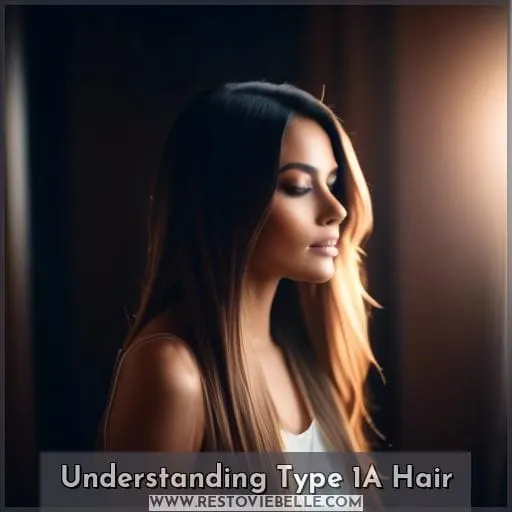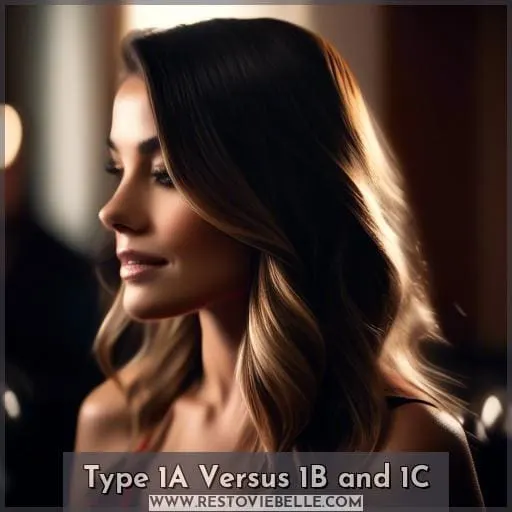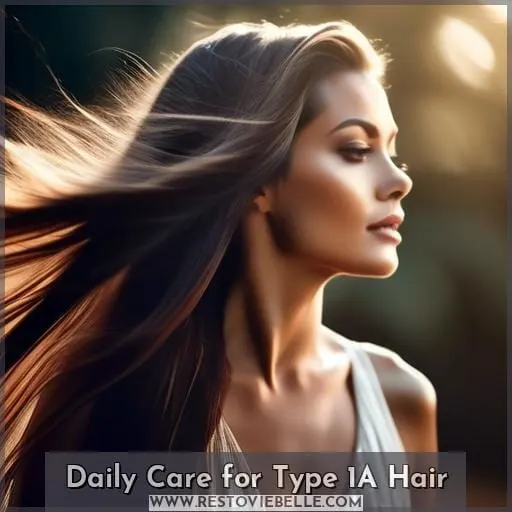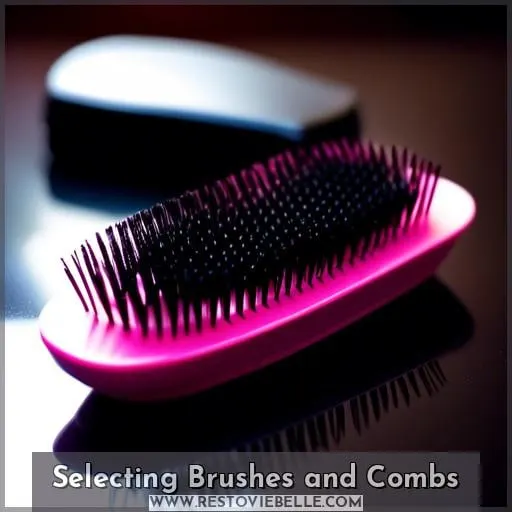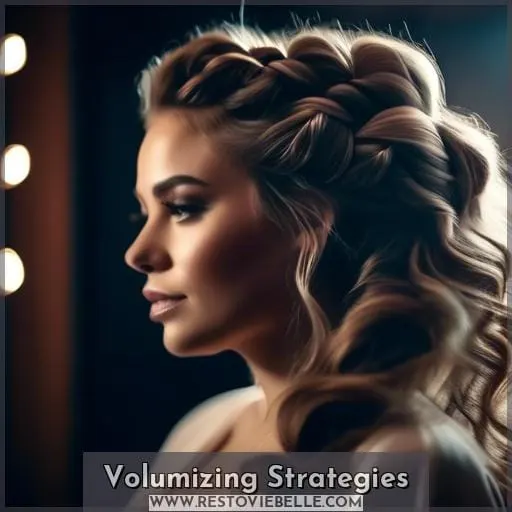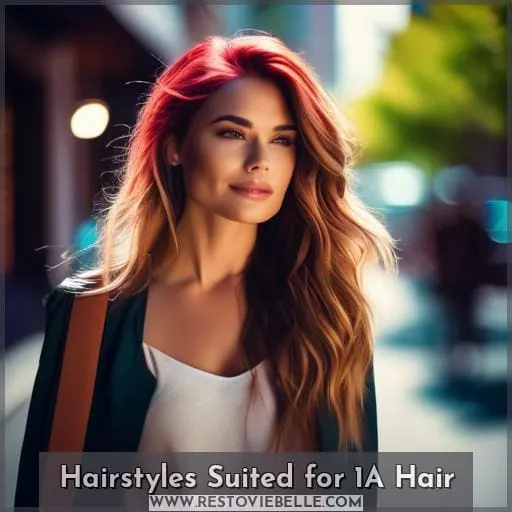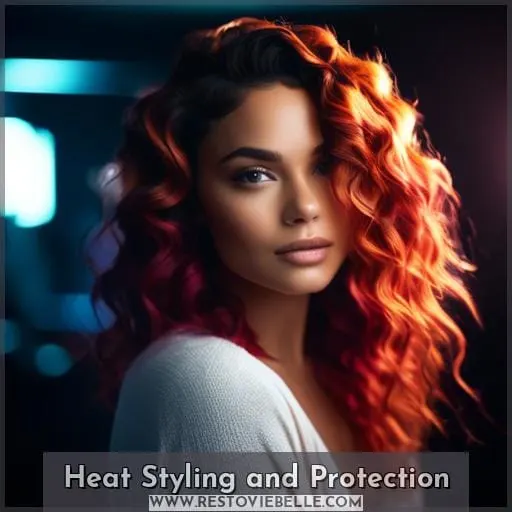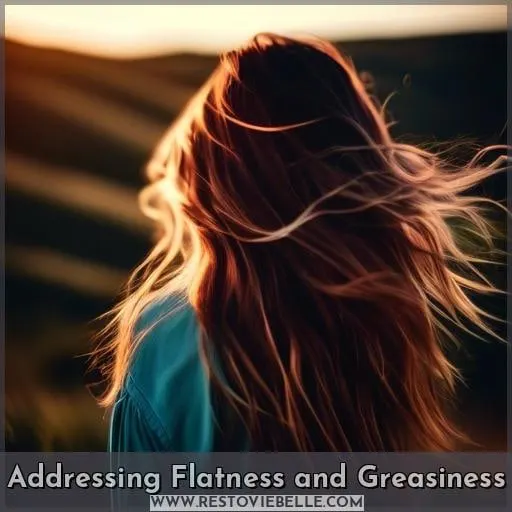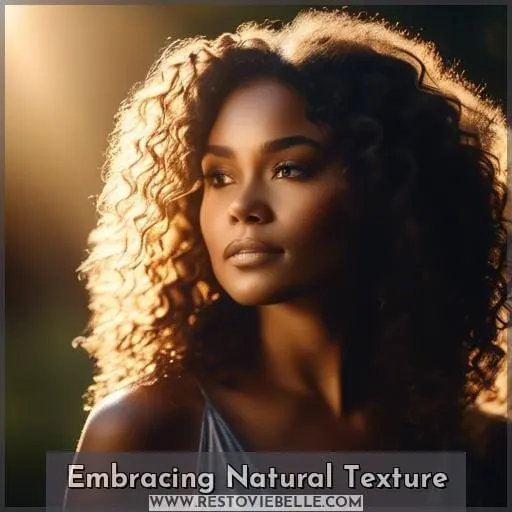This site is supported by our readers. We may earn a commission, at no cost to you, if you purchase through links.
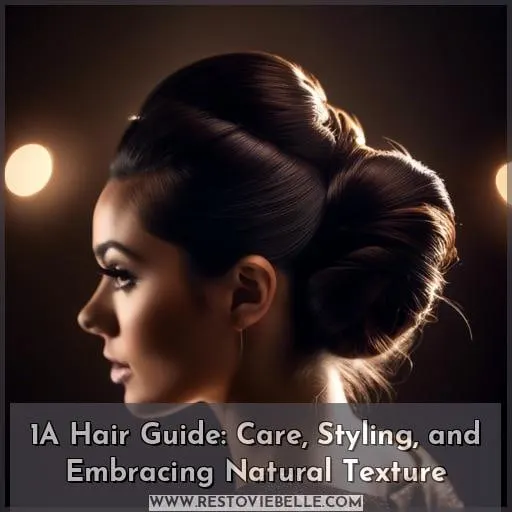 Diving into the world of 1A hair, you’re embarking on a journey to master the art of caring for the straightest, finest strands.
Diving into the world of 1A hair, you’re embarking on a journey to master the art of caring for the straightest, finest strands.
This guide is your key to unlocking the secrets of styling, maintaining, and truly embracing the natural texture of your 1A hair.
With the right knowledge, you’ll discover innovative ways to add volume, control oiliness, and enhance shine, all while celebrating the freedom that comes with understanding your unique hair type.
Let’s explore the elegance of 1A hair together.
Yes, 1A hair is the straightest and finest subtype of Type 1 hair, characterized by its pin-straight appearance and tendency to become greasy quickly due to the ease with which oils travel from the scalp to the ends.
Table Of Contents
- Key Takeaways
- Understanding Type 1A Hair
- Type 1A Versus 1B and 1C
- Daily Care for Type 1A Hair
- Selecting Brushes and Combs
- Volumizing Strategies
- Hairstyles Suited for 1A Hair
- Heat Styling and Protection
- Addressing Flatness and Greasiness
- Embracing Natural Texture
- Frequently Asked Questions (FAQs)
- How does the climate or environment affect the care and styling of Type 1A hair?
- Are there any specific dietary or lifestyle changes that can improve the health and appearance of Type 1A hair?
- How does aging impact the texture and volume of Type 1A hair, and are there any preventive measures?
- Can hormonal changes or medical conditions significantly alter the characteristics of Type 1A hair?
- What are the environmental or ethical considerations when choosing products for Type 1A hair care?
- Conclusion
Key Takeaways
- Type 1A hair is characterized by its pin-straight, fine strands, making it prone to oiliness, fragility, and difficulty in styling due to its fine texture.
- It requires specific care, including balancing shampoo frequency, using lightweight conditioners, and incorporating hair masks and styling creams tailored for its unique needs to maintain scalp health and prevent breakage.
- Compared to Type 1B and 1C hair, which have slightly wavy to coarser strands with more volume, Type 1A hair stands out for its super straight and fine texture, affecting its styling capabilities and the effectiveness of certain hair products.
- Embracing its natural texture involves using products designed for shine enhancement and avoiding heavy products that can weigh down the strands, alongside maintaining a balanced diet for internal nourishment.
Understanding Type 1A Hair
Type 1A hair, characterized by its pin-straight, fine strands, presents a unique set of challenges and advantages in hair care and styling.
Its naturally sleek and shiny texture, while effortlessly maintaining its luster, can often lead to a lack of volume and a tendency towards oiliness.
Understanding how to care for and style this specific hair type is crucial for achieving a balanced look that embraces its natural beauty without weighing it down.
Defining Characteristics
Type 1A hair is unique due to its 100% straight, extremely fine strands that exhibit an effortless shine. However, this hair type is prone to flyaways and split ends. Prioritizing scalp health is crucial for maintaining the overall health of Type 1A hair.
It is essential to choose the right conditioner that can provide moisture without weighing down the strands. To combat hair breakage, incorporating hair masks and styling creams specifically designed for Type 1A hair is recommended.
Additionally, using heat protection products is a must to preserve the delicate texture of this hair type when styling.
Common Challenges
Transitioning from the defining characteristics of Type 1A hair, you may encounter common challenges when caring for this hair type.
- Oily Roots: Your scalp may produce excess oil, leading to a greasy appearance.
- Flat Appearance: Lack of volume can give your hair a weighed-down look.
- Scalp Buildup: Without proper cleansing, products and oils accumulate, hindering hair growth.
- Fragility: Fine strands are prone to breakage, affecting hair styling and potentially contributing to hair loss.
Addressing these issues is crucial for maintaining healthy, vibrant hair.
Type 1A Versus 1B and 1C
Understanding the differences between Type 1A, 1B, and 1C hair is key to embracing your natural texture and finding the right care and styling routine.
If you’ve got 1A hair, you’re dealing with strands that are super straight and fine, setting you apart from the slightly wavier 1B and the thicker, coarser 1C types.
This distinction affects how you’ll style your hair and what products will best suit your locks.
Texture Differences
You’ll notice a significant difference in texture between Type 1A hair, which is extremely fine and straight, and Types 1B and 1C, which offer more body and a slight wave or bend, respectively.
While Type 1A remains sleek, mastering fine hair styling can be challenging. Curl enhancing products and hair mask effectiveness vary, but with the right detangling techniques, you can avoid breakage.
For those rare occasions you crave curls, flat iron techniques can create waves that add dimension to your straight hair.
Styling Capabilities
While type 1A hair is known for its sleekness and difficulty to style due to its fine texture, if you’re looking to add some variety, you’ll find that type 1B and 1C hair offer more natural volume and styling flexibility.
- Curls with Mousse: Apply a lightweight mousse to damp hair and use a diffuser or let air dry for soft waves.
- Sleek with Serum: For a glossy, straight look, use a hair serum to smooth out any flyaways and add shine.
- Braids for Texture: Create braids in damp hair and leave them in overnight for a textured look without heat.
Daily Care for Type 1A Hair
Caring for Type 1A hair involves a delicate balance to maintain its health while addressing its unique challenges. This hair type tends to be oily and lacks volume. For daily care, it’s essential to shampoo your hair with a frequency that prevents it from becoming too greasy without stripping it of natural oils.
Gentle detangling is crucial to avoid breakage. Start from the ends and work your way up, using tools designed to minimize damage to your fine strands. This approach helps maintain the natural shine and silkiness characteristic of Type 1A hair, ensuring it looks its best.
Shampooing Frequency
When managing your Type 1A hair, it’s essential to find a balance in your shampooing routine; daily washing can strip your hair of natural oils, while infrequent washing may leave it looking greasy. Opt for a schedule that keeps your scalp care in check without over-drying. Consider clarifying shampoos for a deep cleanse and hair masks as conditioner alternatives.
| Shampooing Frequency | Benefit |
|---|---|
| Daily | Removes excess oils, prevents limpness |
| Weekly Clarifying | Deep cleanses without stripping natural oils |
| Hair Masks | Moisturizes and strengthens without heaviness |
Gentle Detangling
After establishing a regular shampooing routine, it’s crucial to focus on gentle detangling to prevent breakage and maintain the health of your Type 1A hair.
- Start with a scalp massage to stimulate circulation and promote hair health.
- Use wooden combs to gently work through knots without causing damage.
- Sleep on a silk pillowcase to reduce friction and prevent tangles overnight.
- Rinse with apple cider vinegar after washing to smooth the cuticle and enhance shine.
Selecting Brushes and Combs
When selecting brushes and combs for your Type 1A hair, it’s crucial to choose tools that minimize damage and cater to your hair’s fine texture.
Opt for brushes with soft bristles that are gentle on your delicate strands, ensuring they enhance your hair’s natural shine and smoothness.
Combs should have smooth, rounded teeth to prevent snagging and breakage, especially when your hair is wet and more vulnerable.
Minimizing Damage
In the article ‘A Hair Guide: Care, Styling, and Embracing Natural Texture’, when caring for Type 1A hair, it’s crucial to select the right brushes and combs to minimize damage and maintain hair health.
| Tool | Benefit |
|---|---|
| Wide-tooth comb | Gently detangles, preserving natural oils |
| Soft-bristle brush | Stimulates scalp exfoliation, enhances shine |
| Volumizing brush | Lifts roots, adds body without stress |
| Detangling brush | Reduces breakage, supports air drying |
Choosing wisely lets your hair’s natural beauty shine, embracing innovation and freedom in your care routine.
Brush Types for 1A Hair
One must choose their hairbrush with care, as the right type can enhance your hair’s natural texture and minimize damage.
For your Type 1A hair, a wide-toothed comb is ideal for detangling wet strands without causing breakage.
When seeking volume, apply volumizing products at the roots and use the palm-rolling technique to lift and aerate your hair.
Regular use of a clarifying shampoo will keep your locks free of residue, ensuring they remain light and full of life.
Volumizing Strategies
To give your Type 1A hair the appearance of more volume, start by choosing lightweight formulas that won’t weigh down your delicate strands.
When applying products, focus on the roots where lift is most needed, and use techniques that enhance body without compromising the natural shine and smoothness of your hair.
Lightweight Formulas
While you’re looking to add volume to your Type 1A hair, opt for lightweight formulas that won’t weigh down your strands.
Choose volumizing shampoos and conditioners designed to give your hair a noticeable root lift without the heavy residue.
Incorporate hair masks and scalp treatments into your routine, focusing on products that promise volume and body.
These lightweight products are key to achieving a fuller look while maintaining the natural shine and silkiness of your fine, straight hair.
Application Techniques
Frequently, you’ll find that applying volumizing products at the roots and working your way down ensures maximum lift without weighing your hair down.
Mastering application tips is key to boosting your style while preserving hair health.
Focus on your scalp care; it’s the foundation of vibrant locks.
Understanding your hair’s porosity can guide you in selecting styling products that enhance rather than overwhelm.
This approach not only elevates your look but also nurtures the inherent beauty of your strands.
Hairstyles Suited for 1A Hair
When considering hairstyles for your Type 1A hair, it’s essential to choose cuts that enhance your hair’s natural sleekness while creating the illusion of more volume.
Bangs and layers can be particularly flattering, as they add shape and movement to your hair without compromising its straight texture.
If you’re looking for a change, a collarbone-length cut or strategic face-framing can make a significant impact, giving your fine strands a fuller appearance.
Length and Cuts
When choosing the right length and cut for your Type 1A hair, you’ll want to consider styles that enhance volume and texture without overwhelming your delicate strands.
Opt for collarbone-length cuts or shorter, as these can add a sense of fullness. Experiment with different partings to see what lifts your roots best.
Incorporating textures through subtle layers can also introduce movement. Remember, the right products and accessories, like volumizing sprays and lightweight clips, can elevate your style without weighing down your hair.
Bangs and Layers
For those with Type 1A hair, incorporating bangs and layers can add dimension and style to your look. Choosing the right bangs length and shape can frame your face beautifully, while the strategic placement and length of layers can inject volume and movement.
Consider your face shape when deciding on these elements; soft, feathered layers can lighten the load, preventing your strands from falling flat.
Heat Styling and Protection
When it comes to heat styling and protecting Type 1A hair, it’s crucial to prioritize your hair’s health.
Always apply a lightweight heat protectant before using any heat styling tools to shield your delicate strands from potential damage.
This step helps maintain your hair’s natural shine and smoothness, ensuring it looks its best without compromising its condition.
Avoiding Damage
In transitioning from discussing flattering hairstyles for Type 1A hair, it’s important to consider the impact of heat styling.
Despite its ability to transform your look, heat styling can lead to damage if not managed properly.
To protect your hair’s integrity while using heat tools, you’ll need to arm yourself with a reliable heat protectant.
A heat protectant acts as a barrier against high temperatures and helps maintain your hair’s health and sheen.
Remember to incorporate scalp massages and opt for protective hairstyles to minimize heat damage.
Heat Protectant Use
To seamlessly transition from avoiding damage to discussing heat protectant use, it’s crucial you choose a heat protection product that acts as a damage-preventive measure when styling your Type 1A hair with heat tools.
Opting for the right heat protectant types ensures your natural hair texture remains unharmed while embracing thermal styling techniques.
Proper heat protectant application is key to preserving hair texture, allowing you to experiment with various styles without compromising the health of your strands.
Addressing Flatness and Greasiness
Addressing the challenges of flatness and greasiness in Type 1A hair requires a strategic approach to hair care.
Incorporating dry shampoo into your routine can significantly reduce the appearance of oiliness, giving your hair a fresher, more voluminous look.
This method, along with other oil control techniques, can transform your hair from limp and greasy to lively and textured, making it easier to style and manage.
Dry Shampoo Benefits
Dry shampoo can be your ally in combating the flatness and greasiness often associated with Type 1A hair, offering a quick refresh between washes.
- Explore dry shampoo alternatives like volumizing hair powder to lift roots and add texture.
- Incorporate anti-grease products into your scalp care routine for a balanced, clean feel.
- Enhance your hair’s natural shine with lightweight formulas that won’t weigh down fine strands.
These steps help maintain the effortless elegance of Type 1A hair, ensuring it looks fresh and voluminous.
Oil Control Methods
Following the exploration of dry shampoo benefits, you’ll find that incorporating oil control methods into your routine can significantly reduce flatness and greasiness.
| Method | Benefit | Application Frequency |
|---|---|---|
| Scalp Exfoliation | Removes dead skin, boosts hair growth | Once a week |
| Clarifying Shampoos | Cleanses residue, refreshes scalp | Every 2-3 weeks |
| Volumizing Mousse | Adds body, controls oil | As needed |
| Hair Masks | Deep conditions, without weighing down | Bi-weekly |
These strategies ensure your hair remains vibrant, with a natural lift and less greasiness.
Embracing Natural Texture
When it comes to embracing the natural texture of your Type 1A hair, it’s all about enhancing the shine and choosing the right products.
Your hair’s sleekness is a canvas for radiance, and with the correct selection, you can maintain its luster without a greasy aftermath.
Opt for lightweight conditioners and serums that boost thickness and combat frizz, ensuring they absorb fully to keep your hair looking clean and fresh.
Enhancing Shine
Often, you’ll find that enhancing the natural shine of your Type 1A hair can be achieved through the use of the right products and techniques.
- Apply glossy hair products designed for shine enhancement without weighing down your delicate strands.
- Use natural oils sparingly to nourish your scalp health, contributing to a vibrant sheen.
- Maintain a balanced diet rich in vitamins and minerals, which fortifies hair luster from the inside out.
Product Selection
To enhance and embrace the natural texture of your Type 1A hair, choosing the right products is essential. Tailored for fine strands, focus on deep conditioning without heaviness. Overnight treatments and scalp care are pivotal for nurturing roots and overall health.
Opt for hair masks designed for lightness to avoid weighing down delicate locks. This approach preserves your hair’s natural beauty while encouraging its inherent strength and shine.
Frequently Asked Questions (FAQs)
How does the climate or environment affect the care and styling of Type 1A hair?
In humid climates, Type 1A hair may become straighter and lose any styled curls quickly.
Dry, cold environments mightn’t affect its straightness but can lead to static and dryness.
Adjust your care routine to include lightweight moisturizing products and minimize heat styling to protect your hair’s natural shine and health in varying climates.
Are there any specific dietary or lifestyle changes that can improve the health and appearance of Type 1A hair?
You might wonder if what’s on your plate can truly turn the tide for your delicate, straight locks.
Indeed, incorporating a balanced diet rich in essential nutrients like protein, omega-3 fatty acids, vitamins, and minerals can enhance the strength and shine of your Type 1A hair.
How does aging impact the texture and volume of Type 1A hair, and are there any preventive measures?
Aging can thin and dull 1A hair, reducing its volume and shine.
To counteract, focus on scalp health with nourishing treatments and avoid harsh styling.
Embrace gentle, volumizing routines to maintain its natural beauty.
Can hormonal changes or medical conditions significantly alter the characteristics of Type 1A hair?
Yes, hormonal changes or medical conditions can significantly alter the characteristics of Type 1A hair.
This transformation can affect its texture, volume, and growth patterns like a chameleon adapting to its environment.
What are the environmental or ethical considerations when choosing products for Type 1A hair care?
To select sustainable hair care products that align with your values and the environment’s well-being, focus on items that are:
-
Free from Harmful Chemicals
- Avoid substances like parabens, sulfates (SLS & SLES), phthalates, formaldehydes, and synthetic fragrances known for potential negative impacts on human health and the ecosystem.
-
Packaged Sustainably
- Opt for recyclable materials such as glass bottles, aluminum cans, and biodegradable packaging made of plant-based or compostable materials.
- Choose refillable containers when possible to reduce waste.
-
Ethically Produced
- Support companies committed to fair labor practices, ensuring workers receive living wages and safe working conditions.
- Look for brands that prioritize transparency about their supply chains and manufacturing processes.
By considering these factors, you can make informed decisions about which hair care products best support both personal wellness and global sustainability efforts.
Conclusion
You’ve journeyed through the nuances of 1A hair, uncovering the elegance of its sleek texture.
Now, armed with strategies for volume, oil control, and styling, you’re set to showcase your hair’s natural beauty.
With these tips, your hair won’t just whisper; it’ll make a statement.

